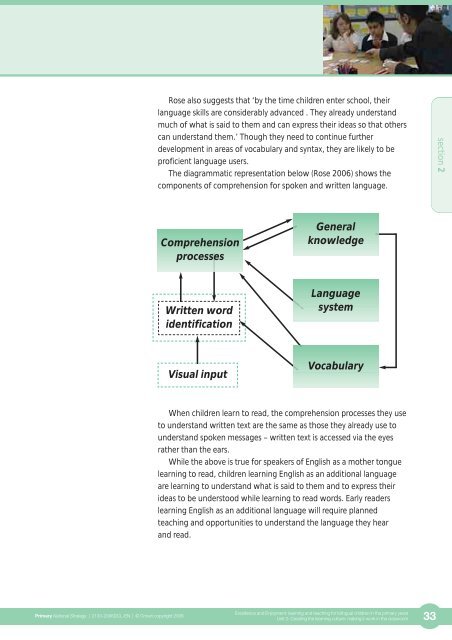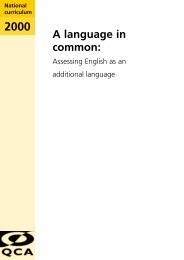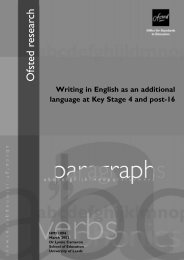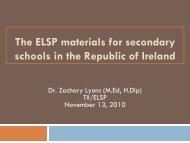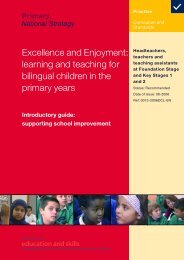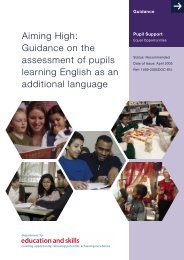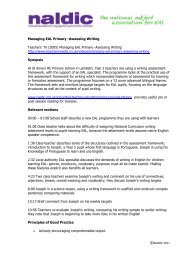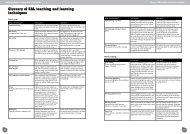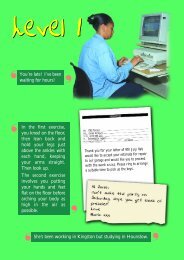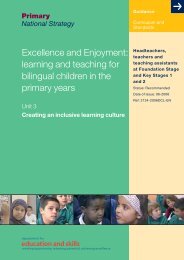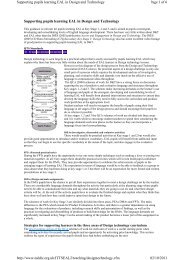Creating a learning culture: Making it work in the classroom - NALDIC
Creating a learning culture: Making it work in the classroom - NALDIC
Creating a learning culture: Making it work in the classroom - NALDIC
Create successful ePaper yourself
Turn your PDF publications into a flip-book with our unique Google optimized e-Paper software.
Rose also suggests that ‘by <strong>the</strong> time children enter school, <strong>the</strong>irlanguage skills are considerably advanced . They already understandmuch of what is said to <strong>the</strong>m and can express <strong>the</strong>ir ideas so that o<strong>the</strong>rscan understand <strong>the</strong>m.’ Though <strong>the</strong>y need to cont<strong>in</strong>ue fur<strong>the</strong>rdevelopment <strong>in</strong> areas of vocabulary and syntax, <strong>the</strong>y are likely to beproficient language users.The diagrammatic representation below (Rose 2006) shows <strong>the</strong>components of comprehension for spoken and wr<strong>it</strong>ten language.section 2ComprehensionprocessesGeneralknowledgeWr<strong>it</strong>ten wordidentificationLanguagesystemVisual <strong>in</strong>putVocabularyWhen children learn to read, <strong>the</strong> comprehension processes <strong>the</strong>y useto understand wr<strong>it</strong>ten text are <strong>the</strong> same as those <strong>the</strong>y already use tounderstand spoken messages – wr<strong>it</strong>ten text is accessed via <strong>the</strong> eyesra<strong>the</strong>r than <strong>the</strong> ears.While <strong>the</strong> above is true for speakers of English as a mo<strong>the</strong>r tongue<strong>learn<strong>in</strong>g</strong> to read, children <strong>learn<strong>in</strong>g</strong> English as an add<strong>it</strong>ional languageare <strong>learn<strong>in</strong>g</strong> to understand what is said to <strong>the</strong>m and to express <strong>the</strong>irideas to be understood while <strong>learn<strong>in</strong>g</strong> to read words. Early readers<strong>learn<strong>in</strong>g</strong> English as an add<strong>it</strong>ional language will require plannedteach<strong>in</strong>g and opportun<strong>it</strong>ies to understand <strong>the</strong> language <strong>the</strong>y hearand read.Primary National Strategy | 2133-2006DCL-EN | © Crown copyright 2006Excellence and Enjoyment: <strong>learn<strong>in</strong>g</strong> and teach<strong>in</strong>g for bil<strong>in</strong>gual children <strong>in</strong> <strong>the</strong> primary yearsUn<strong>it</strong> 2: <strong>Creat<strong>in</strong>g</strong> <strong>the</strong> <strong>learn<strong>in</strong>g</strong> <strong>culture</strong>: mak<strong>in</strong>g <strong>it</strong> <strong>work</strong> <strong>in</strong> <strong>the</strong> <strong>classroom</strong> 33


